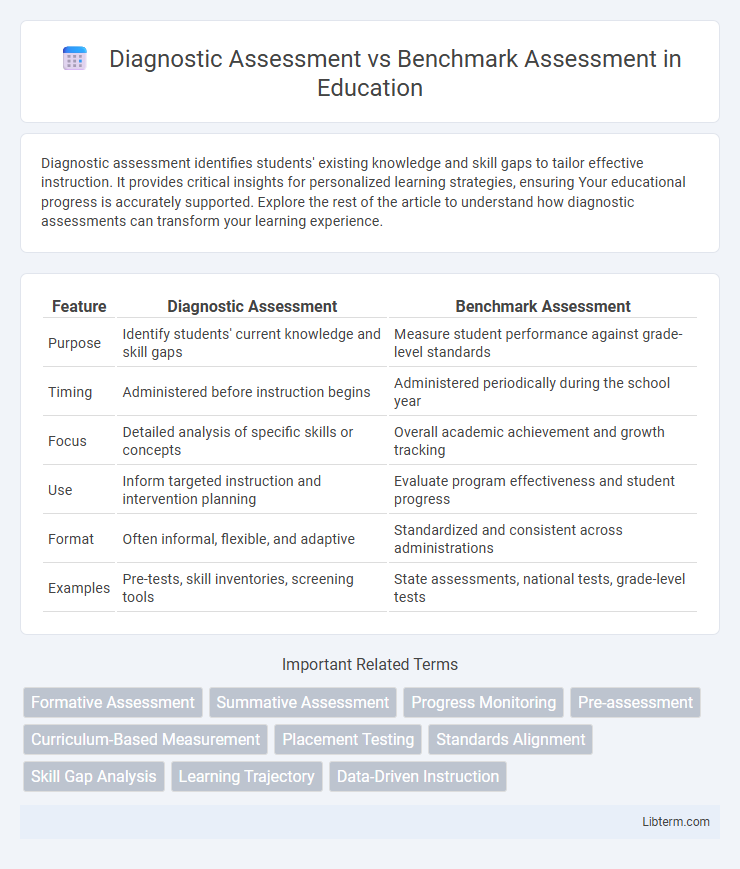Diagnostic assessment identifies students' existing knowledge and skill gaps to tailor effective instruction. It provides critical insights for personalized learning strategies, ensuring Your educational progress is accurately supported. Explore the rest of the article to understand how diagnostic assessments can transform your learning experience.
Table of Comparison
| Feature | Diagnostic Assessment | Benchmark Assessment |
|---|---|---|
| Purpose | Identify students' current knowledge and skill gaps | Measure student performance against grade-level standards |
| Timing | Administered before instruction begins | Administered periodically during the school year |
| Focus | Detailed analysis of specific skills or concepts | Overall academic achievement and growth tracking |
| Use | Inform targeted instruction and intervention planning | Evaluate program effectiveness and student progress |
| Format | Often informal, flexible, and adaptive | Standardized and consistent across administrations |
| Examples | Pre-tests, skill inventories, screening tools | State assessments, national tests, grade-level tests |
Understanding Diagnostic Assessment
Diagnostic assessment identifies students' existing knowledge, skills, and learning gaps before instruction begins, offering precise insights into individual strengths and weaknesses. It involves in-depth evaluations such as formative tests, interviews, and skill inventories to tailor targeted interventions and personalized learning plans. This approach enhances instructional effectiveness by addressing specific educational needs rather than relying on generalized performance measures characteristic of benchmark assessments.
Defining Benchmark Assessment
Benchmark assessment measures student performance against established standards at specific points in the academic year to monitor progress and guide instruction. Unlike diagnostic assessments, which identify specific learning gaps and needs, benchmark assessments provide comparative data across classrooms or schools to evaluate overall achievement and growth trends. Effective use of benchmark data ensures alignment with curriculum goals and informs adjustments to teaching strategies.
Key Purposes of Diagnostic Assessment
Diagnostic assessment primarily aims to identify students' existing knowledge, skills, and learning gaps to tailor instruction effectively. It provides detailed insights into strengths and weaknesses at the individual or group level, facilitating targeted intervention and personalized support. This assessment is crucial for informing instructional planning and improving student outcomes by addressing specific learning needs.
Main Functions of Benchmark Assessment
Benchmark assessments primarily function to measure student performance at regular intervals, providing data to compare against established academic standards or goals. These assessments identify trends in learning progress, allowing educators to adjust instruction and interventions efficiently. By tracking growth over time, benchmark assessments support accountability and curriculum effectiveness monitoring within educational systems.
Differences in Assessment Timing
Diagnostic assessments are administered before instruction begins to identify students' pre-existing knowledge, skills, and learning gaps, enabling targeted teaching strategies. Benchmark assessments occur periodically throughout the academic year, providing data on student progress relative to grade-level standards and helping to adjust instruction as needed. The key distinction lies in timing: diagnostic assessments are pre-instructional, while benchmark assessments are mid- and post-instructional tools.
Data Utilization: Diagnostic vs Benchmark
Diagnostic assessments provide detailed data on individual student strengths and weaknesses, enabling educators to tailor instruction and interventions specifically to student needs. Benchmark assessments offer periodic data to measure overall student performance against established standards, helping schools monitor progress and adjust curriculum pacing. While diagnostic data drives personalized learning strategies, benchmark data supports school-wide performance tracking and accountability.
Impact on Instructional Decision-Making
Diagnostic assessments provide detailed insights into students' strengths and weaknesses, enabling educators to tailor instruction to address specific learning gaps effectively. Benchmark assessments measure overall student progress against established standards at key points, guiding curriculum pacing and instructional adjustments. The combination of both assessments enhances precision in instructional decision-making, ensuring targeted interventions and improved student outcomes.
Advantages and Limitations of Diagnostic Assessment
Diagnostic assessment provides detailed insights into individual student learning gaps, enabling personalized instruction and targeted interventions. Its advantages include the ability to identify specific strengths and weaknesses, promoting tailored teaching strategies that enhance learning outcomes. Limitations involve the time-intensive nature of administration and analysis, potential for student anxiety due to in-depth evaluation, and challenges in maintaining consistent implementation across diverse classroom settings.
Pros and Cons of Benchmark Assessment
Benchmark assessments provide regular data points to track student progress across key standards, enabling targeted instruction and timely interventions. Their standardized nature allows for comparison within and across grade levels but may not capture individual learning gaps in as much depth as diagnostic assessments. While efficient for monitoring overall achievement trends, benchmark assessments can sometimes oversimplify complex learning needs and foster teaching to the test.
Best Practices for Integrating Both Assessments
Effective integration of diagnostic and benchmark assessments involves using diagnostic tools to identify students' specific learning gaps and strengths early in the academic year, allowing for tailored instruction. Benchmark assessments should be scheduled periodically to monitor progress against grade-level standards, providing actionable data to adjust teaching strategies and interventions. Combining both assessments ensures a comprehensive approach that supports personalized learning paths and continuous academic growth.
Diagnostic Assessment Infographic

 libterm.com
libterm.com